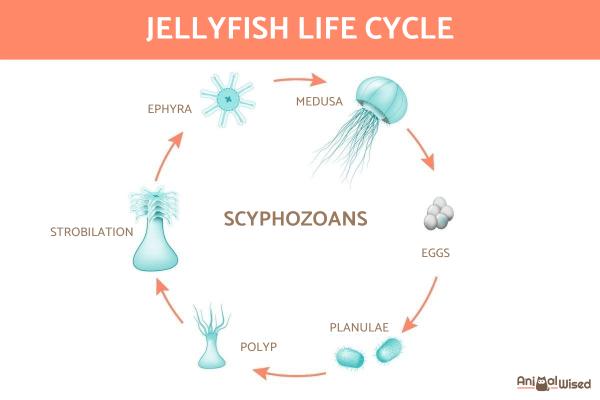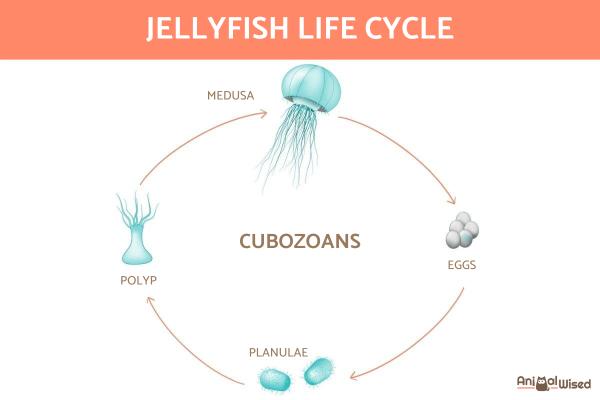How Are Jellyfish Born? - Jellyfish Reproduction


How a jellyfish is born will depend on the species since jellyfish can reproduce both sexually and asexually. Despite having a relatively simple morphology, jellyfish reproduction can be an often complicated process and has certain features which are distinct to their species. Jellyfish belong to the phylum Cnidaria which also contains other marine life such as sea anemones. Specifically, these cnidarians are known for their gelatinous body which is bell shaped and has a single body cavity. They have tentacles with specialized cells called cnidocytes, used for protection by producing a harmful sting. These animals are characterized by having two phases during their development. The first are the juvenile polyps which attach to the substrate and the other is the adult jellyfish which swims freely.
With this background in mind, AnimalWised asks how are jellyfish born? We look at the different types of jellyfish reproduction and how they physically carry out this behavior.
Do jellyfish lay eggs?
In the introduction, we have distinguished between the adult jellyfish known as a medusa and the juvenile polyp. In terms of reproduction, this distinction is very important. We start by looking at the adult jellyfish form.
In general, most species of jellyfish are dioecious, meaning male and female reproductive organs are found on separate individuals. For sexual reproduction to occur, they both release their gametes into seawater. Once released, the spermatozoa fertilize the ovules as a type of external fertilization. The female cares for these eggs by protecting them with her tentacles. This gives them time to incubate.
Since they incubate eggs, most jellyfish are considered oviparous animals. However, some jellyfish are considered ovoviviparous since the female takes up the eggs which have been released into the water after fertilization and will incubate them inside for a time[1]. These include jellyfish from the families Carybdeidae and Alatinidae.
There are species where the same individual has both male and female sex organs. This means they are types of hermaphrodite animals. Species of hermaphrodite jellyfish are very rare, although there are some reported cases such as certain moon jellyfish contained within the genus Aurelia.
With hermaphrodite jellyfish, the individual themselves releases the two types of gametes into the water, without the intervention of another individual. Although they reproduce asexually, they still have eggs.
Although the sexual reproduction of jellyfish is often complicated and differs according to both species and individuals within a certain species, we can say that adult jellyfish generally reproduce sexually and juvenile polyps reproduce asexually. The latter do so through a process known as strobilation in which budding of new jellyfish occurs.
Jellyfish have alternating generations, meaning they have two phases during their life cycle. They start as a polyp and later become a medusa. In short, how a jellfish is born is a fascinating process since it has more than one form of reproduction.
How are jellyfish born?
The reproductive cycle of jellyfish is characterized by alternation of generations. The juvenile polyps are sessile, meaning they cannot move on their own. They are usually attached to parts of the substrate such as on coral or even on other marine invertebrates. This from an carry out asexual reproduction. Free-living and pelagic jellyfish reproduce sexually.
Jellyfish eggs are incubated between the mother's tentacles. After it develops sufficiently, a larva called a planula is born. When it is ready to become independent, this larva floats free from its mother. After a few days, it descends until it finds a place to adhere, usually on the seabed. It is at this stage it is called a polyp. During this stage, metamorphosis occurs and its shape changes. It develops cilia and a suction cup that allows it to adhere.
During the polyp stage, the jellyfish's appearance is similar to a sea anemone. The polyp feeds on plankton as it slowly matures. When it is ready, the polyp reproduces asexually and forms a colony of small polyps. They arise from the stem of the parent. New members of the colony develop tubes through which they can feed.
This poly phase of the jellyfish life cycle will continue depending on the conditions of its environment. This means it can last from days to several years if the conditions are unfavorable. It is during the next phase of development when the dissolution of the colony occurs. This is when hundreds to thousands of miniature jellyfish are released. This process is known as a jellyfish bloom.
Learn more about jellyfish behavior with our article on what jellyfish eat.

How many babies can jellyfish have?
Depending on the species, jellyfish are capable of laying hundreds of eggs. From these eggs small free-swimming larvae known as planulae will emerge. As we explained, life begins in the mother's tentacles. They then begin to swim freely until they find a place to settle. The polyp will then feed and grow into an adult jellyfish. The number of offspring of each jellyfish is not defined. We do know they can lay hundreds of eggs, some studied species lay close to 500. Despite such a large number of eggs, only a small percentage develop.
Birth of jellyfish according to type
As already mentioned, these unique animals are classified in the Cnidaria phylum. They all have certain features which are common to the species. This includes the cnidocytes which allow them to defend themselves against predators. Unlike other species with cnidocytes, those on jellyfish are found in their tentacles. This allows them to kill their prey before being digested.
The term jellyfish is used to refer to hundreds of species that in turn are classified into three large classes. Also known as sea jellies, they all have the polyp and medusa forms, but some species differ according to birth. It is important to note we are only discussing animals from the phylum Cnidaria. This does not include related, but different phyla such as comb jellies.
In the next section we look at the reproduction of jellyfish in more detail by examining specific species and types:

Hydromedusae or hydrozoans
This class is made up of both freshwater and seawater species and have alternation of generations. These are the benthic polyps which are asexual and the planktonic jellyfish which are sexual. Many species form colonies of polyps which grow together thanks to a system of tubelike hydrocauli. Each hydrocaulus is protected by an exoskeleton made of chitin.
Unlike the other classes, hydromedusae differ by presenting a mesoglea. This is a structure formed by a gelatinous mass that separates the layers of epithelium and is devoid of living cells. It is generally made up of collagen. They do not have cnidocytes in the skin of their stomach (i.e. the gastrodermis), but they are present in the tentacles which have a powerful poison.
These species make up colonies where each hydrozoa fulfills a certain function. In this way, some are in charge of digestion (called gastrozooids), some are in charge of defending the colony (called dactylozooids) and others are responsible for reproductive functions (gonozoids). A particular detail is that each gonozoid produces asexual polyps that form sessile colonies, which will transform into sexual jellyfish.

True jellyfish or scyphozoans
The representatives of this class are those most commonly associated jellyfish. They contain very large species, such as the lion's mane jellyfish (Cyanea capillata) which can reach almost three meters in length including its tentacles. They also incorporated very small jellyfish that barely reach 2 cm in length.
This class is characterized by having a very short polyp stage. They spend most of their life in the medusa stage. They reproduce sexually by producing eggs from which a planula larva will develop. The larva grows until it is ready for strobilation to occur. Also known as transverse fission, strobilation is the process by which small jellyfish called ephyras originate.
The transverse fission of these jellyfish consists of the division of a kind of superimposed discs, all of them with the same DNA. It is a type of asexual reproduction, so each disc released is an ephyra. Within a short period of time, it will transform into a small jellyfish that will grow until it reaches the adult stage. At this time its biological cycle is complete.
Learn more about the different types of jellyfish.

Box jellyfish or cubozoans
This class consists of species distributed in the Philippines, Australia and other tropical regions. They are also known as sea wasps, a name that derives from their dangerous venom present in their tentacles. This is injected through the nematocysts in their tentacles, a structure that inoculates the toxin into its prey like a harpoon.
They are characterized by having a velarium, a structure that resembles the veil present in hydromedusae. In hydromedusae, the veil is a fold of tissue located below the umbel. This is the structure where the mouth is located below. It is concave and gives it the shape of a bell, separating the internal part from the external part. In the case of box jellyfish, the velarium is a structure that is involved in digestion.
In addition, box jellyfish have rhopalia, sensory organs that act as eyes. They allow the ability to orient themselves thanks to the presence of photoreceptors. They are box-shaped, hence the common name of their class. They are of a very characteristic blue color. In this class, strobilation does not occur during reproduction. It is known that some species can copulate and that only one jellyfish emerges from each polyp after metamorphosis.

If you want to read similar articles to How Are Jellyfish Born? - Jellyfish Reproduction, we recommend you visit our Facts about the animal kingdom category.
1. Bentlage, B., Cartwright, P., Yanagihara, A. A., Lewis, C., Richards, G. S., & Collins, A. G. (2010). Evolution of box jellyfish (Cnidaria: Cubozoa), a group of highly toxic invertebrates. Proceedings. Biological sciences, 277(1680), 493–501.
https://doi.org/10.1098/rspb.2009.1707
- Cortes, J. (1996). Marine Biodiversity of Costa Rica: Phylum Cnidaria. Journal of Tropical Biology, 323-334.
- Deserti, I. (2012). Freshwater cnidarians: the hydras. Biological Bulletin, 25, 1-8.
- Harrison, F. W., & Westfall, J. A. (1991). Placozoa, Porifera, Cnidaria and Ctenophora. (No. 593.1 MIC).
- Jáquez-Bermúdez, L. S., Celis-Gutiérrez, L., & del Carmen Franco-Gordo, M. Jellyfish (Cnidaria: Medusozoa) from the southern coast of Jalisco and Colima. Maria del Carmen Franco-Gordo (ed.), 32.









